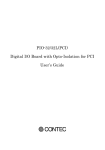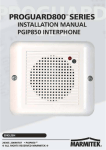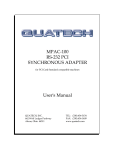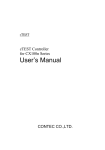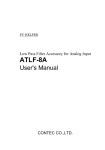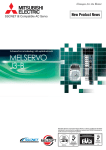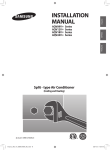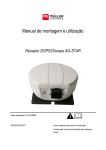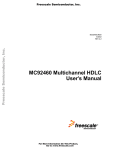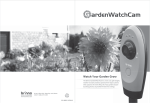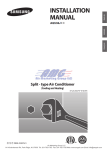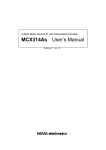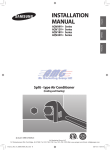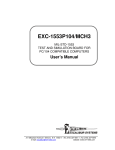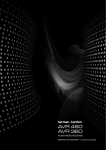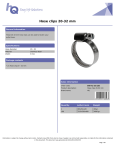Download PIO-16/16B(PCI) PI-32B(PCI) PO
Transcript
PIO-16/16B(PCI) PI-32B(PCI) PO-32B(PCI) Digital I/O Board with Opto-Isolation for PCI User’s Guide Copyright Copyright 2000 CONTEC Co., LTD. ALL RIGHTS RESERVED No part of this document may be copied or reproduced in any form by any means without prior written consent of CONTEC Co., LTD. CONTEC Co., LTD. makes no commitment to update or keep current the information contained in this document. The information in this document is subject to change without notice. All relevant issues have been considered in the preparation of this document. Should you notice an omission or any questionable item in this document, please feel free to notify CONTEC Co., LTD. Regardless of the foregoing statement, CONTEC assumes no responsibility for any errors that may appear in this document nor for results obtained by the user as a result of using this product. Trademarks MS, Microsoft, MS-DOS and Windows are trademarks of Microsoft Corporation. Other brand and product names are trademarks of their respective holder. PIO-16/16B(PCI), PI-32B(PCI), PO-32B(PCI) i Product Configuration - Board [PIO-16/16B(PCI), PI-32B(PCI) or PO-32B(PCI)]…1 - Setup Program Diskette (3.5inch/1.44MB) …1 - User’s Guide (this booklet)…1 Unpacking: This board is specially packed in an anti-static bag to prevent damage in shipping. Check the contents to make sure that you have everything listed above. If you do not have all the items, contact your distributor or CONTEC group office where you purchased. Note! Do not remove the board from its protective packaging until the computer case is open and ready for installation. Electrical static can cause damage to electrical components. ii PIO-16/16B(PCI), PI-32B(PCI), PO-32B(PCI) Table of Contents Copyright ............................................................................i Trademarks ........................................................................i Product Configuration ..................................................... ii 1. Introduction ............................................................. 1 About the Board ............................................................1 Features.........................................................................1 Limited Three-Year Warranty......................................2 How to Obtain Service..................................................2 Liability .........................................................................2 Handling Precautions...................................................3 About the Manual .........................................................4 2. Component Locations and Setting .............................. 5 Component Locations........................................................5 Setting the Board ID.........................................................6 Setting Procedure .........................................................6 Setting the Interrupt Use.................................................7 Selecting Power Supply ....................................................8 Setting method..............................................................8 3. Board Setup ............................................................. 9 Use CONTEC Windows Software Products.....................9 Without CONTEC Software Product .............................10 For Windows 98 Systems............................................10 For Windows 95 Systems............................................14 For other OS systems .................................................19 4. External Connection ............................................... 21 Interface Connector.........................................................21 Connecting the Interface Connector ..........................21 Interface Connector Pin Assignment.........................22 Input Circuit and Output Circuit...................................24 Surge Protection..............................................................27 PIO-16/16B(PCI), PI-32B(PCI), PO-32B(PCI) iii 5. I/O Ports and Registers ........................................... 29 I/O Address Map..............................................................29 Input/Output Data by Direct Access to I/O Ports..........35 Data Input...................................................................35 Data Output ................................................................36 Input/Output Data by Bit Number ................................38 Input a Bit Data..........................................................41 Output a Bit Data .......................................................41 Input/Output Data by Group Number ...........................42 Input a Group Data ....................................................45 Output a Group Data..................................................45 Digital Filter Function of Input Channels ....................46 Digital Filter Function Principle ...............................46 Set Digital Filter Time ...............................................47 Confirm the Digital Filter Setting Data ....................48 Output Data Monitor Function ......................................49 Input from an I/O Port................................................50 Confirm an Output Bit ...............................................50 Monitor Output Data by Port Number ......................50 Interrupt Control Function ............................................51 Set Interrupt Events...................................................52 Interrupt Event Masking ...........................................53 Interrupt Status Register...........................................53 Check Interrupt Setting .............................................54 Clear Interrupt Request Signal .................................54 6. System Reference.................................................... 55 PIO-16/16B(PCI) Block Diagram ...................................55 PIO-16/16B(PCI) Specifications .....................................56 PI-32B(PCI) Block Diagram ...........................................58 PI-32B(PCI) Specifications .............................................59 PO-32B(PCI) Block Diagram..........................................61 PO-32B(PCI) Specifications............................................62 7. Troubleshooting ...................................................... 63 8. Index ..................................................................... 65 iv PIO-16/16B(PCI), PI-32B(PCI), PO-32B(PCI) List of Figures Figure 2.1. Component Locations............................................... 5 Figure 2.2. Board ID Settings (SW1).......................................... 6 Figure 2.3. Setting the Interrupt Use........................................... 7 Figure 2.4. Power Supply Selecting............................................ 8 Figure 3.1. Sample Programs on FD......................................... 19 Figure 4.1. Interface Connector ................................................ 21 Figure 4.2. Pin Assignments of Interface Connector <PIO-16/16B(PCI)> ............................................... 22 Figure 4.3. Pin Assignments of Interface Connector <PI-32B(PCI)>....................................................... 23 Figure 4.4. Pin Assignments of Interface Connector <PO-32B(PCI)> ..................................................... 23 Figure 4.5. Input Circuit <PIO-16/16B(PCI)>, <PI-32B(PCI)> ..................... 24 Figure 4.6. Output Circuit <PIO-16/16B(PCI)>, <PO-32B(PCI)> ................... 25 Figure 4.7. Connection Example of Input Signal <PIO-16/16B(PCI)>, <PI-32B(PCI)> ..................... 26 Figure 4.8. Connection Example of Output Signal <PIO-16/16B(PCI)>, <PO-32B(PCI)> ................... 26 Figure 4.9. Sample of Voltage Surge Protection........................ 27 Figure 5.1. Input Port Assignments <PIO-16/16B(PCI)> ......... 29 Figure 5.2. Output Port Assignments <PIO-16/16B(PCI)>....... 30 Figure 5.3. Input Port Assignments <PI-32B(PCI)> ................. 31 Figure 5.4. Output Port Assignments <PI-32B(PCI)>............... 32 Figure 5.5. Input Port Assignments <PO-32B(PCI)>................ 33 Figure 5.6. Output Port Assignments <PO-32B(PCI)> ............. 34 PIO-16/16B(PCI), PI-32B(PCI), PO-32B(PCI) v Figure 5.7. Input Port " I/O Address +0H ~ 1H " <PIO-16/16B(PCI)> ............................................... 35 Figure 5.8. Input Port " I/O Address +0H ~ 3H " <PI-32B(PCI)>....................................................... 35 Figure 5.9. Output Port " I/O Address +2H ~ 3H " <PIO-16/16B(PCI)> ............................................... 36 Figure 5.10. Output Port " I/O Address +0H ~ 3H " <PO-32B(PCI)> ..................................................... 36 Figure 5.11. Input Port " I/O Address +0H ~ 3H " and " I/O Address +AH " <PIO-16/16B(PCI)>....... 38 Figure 5.12. Output Port " I/O Address +0H ~ 3H " and " I/O Address +AH ~ BH " <PIO-16/16B(PCI)> .... 38 Figure 5.13. Input Port " I/O Address +0H ~ 3H " and " I/O Address +AH " <PI-32B(PCI)>............... 39 Figure 5.14. Output Port " I/O Address +BH " <PI-32B(PCI)> .. 39 Figure 5.15. Input Port " I/O Address +0H ~ 3H " and " I/O Address +AH " <PO-32B(PCI)> ............. 40 Figure 5.16. Output Port " I/O Address +0H ~ 3H " and " I/O Address +AH ~ BH " <PO-32B(PCI)>.... 40 Figure 5.17. Input Port " I/O Address +0H ~ 3H " and " I/O Address + CH " <PIO-16/16B(PCI)> ...... 42 Figure 5.18. Output Port " I/O Address +0H ~ 3H " and " I/O Address +CH ~ DH " <PIO-16/16B(PCI)> .... 42 Figure 5.19. Input Port " I/O Address +0H ~ 3H " and " I/O Address + CH " <PI-32B(PCI)>.............. 43 Figure 5.20. Output Port " I/O Address +DH " <PI-32B(PCI)>.. 43 Figure 5.21. Input Port " I/O Address +0H ~ 3H " and " I/O Address + CH " <PO-32B(PCI)> ............ 44 Figure 5.22. Output Port " I/O Address +0H ~ 3H " and " I/O Address +CH ~ DH " <PO-32B(PCI)>.... 44 vi PIO-16/16B(PCI), PI-32B(PCI), PO-32B(PCI) Figure 5.23. Digital Filter Operation Principle ........................... 46 Figure 5.24. I/O Ports of Digital Filter Function......................... 46 Figure 5.25. Digital Filter Time and Setting Data....................... 47 Figure 5.26. Input Port " I/O Address + 2H ~ 3H " <PIO-16/16B(PCI)> ............................................... 49 Figure 5.27. Input Port " I/O Address +0H ~ 3H " <PO-32B(PCI)> ..................................................... 49 Figure 5.28. Input Port Assignment of Interrupt Function .......... 51 Figure 5.29. Output Port Assignment of Interrupt Function........ 51 Figure 5.30. Explanation of Interrupt Setting Register................ 52 Figure 6.1. Block Diagram <PIO-16/16B(PCI)> ...................... 55 Figure 6.2. Block Diagram <PI-32B(PCI)> .............................. 58 Figure 6.3. Block Diagram <PO-32B(PCI)>............................. 61 List of Tables Table 6.1. Specifications <PIO-16/16B(PCI)>........................... 56 Table 6.2. Specifications <PI-32B(PCI)> .................................. 59 Table 6.3. Specifications <PO-32B(PCI)> ................................. 62 PIO-16/16B(PCI), PI-32B(PCI), PO-32B(PCI) vii viii PIO-16/16B(PCI), PI-32B(PCI), PO-32B(PCI) Introduction 1. Introduction About the Board PIO-16/16B(PCI), PI-32B(PCI), PO-32B(PCI), are PCI buscompatible add-on interface boards designed for isolated digital input/output. Plugged in a PCI bus expansion slot on the motherboard of a personal computer, <PIO-16/16B(PCI)> can input and output up to 16 channels. <PI-32B(PCI)> can input up to 32 channels. <PO-32B(PCI)> can output up to 32 channels. Features PCI bus-compatible interface board is available to IBM PC compatibles PC in which PCI bus slots have been installed. - Opto-isolated input/output providing improved noise resistance. - <PIO-16/16B(PCI)> performs up to 16 (8 signals x 2 groups) current source type input and up to 16 (8 signals x 2 groups) current sink type output. - <PI-32B(PCI)> performs up to 32 (8 signals x 4 groups) current source type input. - <PO-32B(PCI)> performs up to 32 (8 signals x 4 groups) current sink type output. - Four input signals can also generate interrupt requests. <PIO-16/16B(PCI)>, <PI-32B(PCI)> - Up to 35VDC, 100mA per signal, max. output. <PIO-16/16B(PCI)>, <PO-32B(PCI)> - Equips an on board isolated power supply (12VDC, 240mA) for driving photo-insulation circuits. - In addition to its general-purpose input/output function, this board also supports: - Digital filter for input signals - Output data monitor - Bit input/output function - Group input/output function For details, refer to "Chapter 5 : I/O Ports and Registers" PIO-16/16B(PCI), PI-32B(PCI), PO-32B(PCI) 1 Introduction Limited Three-Year Warranty CONTEC Interface boards are warranted by CONTEC Co., LTD. to be free from defects in material and workmanship for up to three years from the date of purchase by the original purchaser. Repair will be free of charge only when this device is returned freight prepaid with a copy of the original invoice and a Return Merchandise Authorization to the distributor or the CONTEC group office, from which it was purchased. This warranty is not applicable for scratches or normal wear, but only for the electronic circuitry and original boards. The warranty is not applicable if the device has been tampered with or damaged through abuse, mistreatment, neglect, or unreasonable use, or if the original invoice is not included, in which case repairs will be considered beyond the warranty policy. How to Obtain Service For replacement or repair, return the device freight prepaid, with a copy of the original invoice. Please obtain a Return Merchandise Authorization Number (RMA) from the CONTEC group office where you purchased before returning any product. * No product will be accepted by CONTEC group without the RMA number. Liability The obligation of the warrantor is solely to repair or replace the product. In no event will the warrantor be liable for any incidental or consequential damages due to such defect or consequences that arise from inexperienced usage, misuse, or malfunction of this device. 2 PIO-16/16B(PCI), PI-32B(PCI), PO-32B(PCI) Introduction Handling Precautions Take the following precautions when handling this board. - Do not modify the board. CONTEC will bear no responsibility for any problems, etc., resulting from modifying this board. - Do not strike or bend the board. Doing so could damage the board. - Do not touch the board's metal plated terminals (edge connector) with your hands. Doing so could cause connection malfunctions. If the terminals are touched by someone's hands, clean the terminals with industrial alcohol. - There are switches on the board that need to be set in advance. Be sure to check these before installing the board. - Only set the switches and jumpers on the board to the specified settings. Doing otherwise would cause trouble. - Install the board in the computer's PCI expansion slot. - Do not install or remove the board to or from the slot while the computer's power is turned on. Doing so could cause trouble. Be sure that the personal computer or the I/O expansion unit power is turned off. - The sum of the power consumed by the boards installed in the personal computer's PCI bus expansion slots cannot be larger than the personal computer's allowable power supply capacity. If the boards' power sum is larger than this capacity, trouble could occur. PIO-16/16B(PCI), PI-32B(PCI), PO-32B(PCI) 3 Introduction About the Manual This manual consists of the following chapters: 4 Chapter 1 Introduction Chapter 2 Component Locations and Setting This chapter explains the names of major parts on the board and its switch setting. Chapter 3 Board Setup This chapter describes the procedures for setting up the board. Chapter 4 External Connection This chapter explains how to connect external devices to the board. Chapter 5 I/O Ports and Registers This chapter provides the assignment and definition of each I/O port bit used for the board. Chapter 6 System Reference This chapter summarizes hardware specifications of the board and provides circuit block diagrams. Chapter 7 Troubleshooting This chapter asks a set of questions you need to answer when you are in trouble with your board. It also includes a checklist to fill out before calling CONTEC group office for help. Chapter 8 Index PIO-16/16B(PCI), PI-32B(PCI), PO-32B(PCI) Component Locations and Setting 2. Component Locations and Setting Component Locations Figure 2.1. shows the names of major parts on the board. Note that the switch setting shown below is the factory default. Figure 2.1. Component Locations PIO-16/16B(PCI), PI-32B(PCI), PO-32B(PCI) 5 Component Locations and Setting Setting the Board ID If you install two or more boards on one personal computer, assign a different ID value to each of the boards to distinguish them. The board IDs can be set from 0 to F to identify up to sixteen boards. If only one board is used, the original factory setting (Board ID = 0) should be used. Setting Procedure To set the board ID, use the rotary switch on the board. Turn the SW1 knob to set the board ID as shown below. 23 7 9 B C DE A 4 56 SW1 BOARD ID Factory default: (BOARD ID = 0) F01 Figure 2.2. Board ID Settings (SW1) 6 PIO-16/16B(PCI), PI-32B(PCI), PO-32B(PCI) Component Locations and Setting Setting the Interrupt Use <PIO-16/16B(PCI)>, <PI-32B(PCI)> can use input signals to issue interrupt requests to the PC. If you don't use the Interrupt function, you can let your PC recognize the board as a no-interrupt function board in order to save the Interrupt resources of PC. When the interrupt is used, this board is assigned an interrupt level by your PC. Setup when interrupt is used Setup when interrupt is not used JP1 INT JP1 INT USE NOT USE 1 2 3 (Factory setting of <PIO-16/16B(PCI)>, <PI-32B(PCI)>) USE NOT USE 1 2 3 (Factory setting of <PO-32B(PCI)>) Figure 2.3. Setting the Interrupt Use <PO-32B(PCI)> can’t issue interrupt requests. The original factory setting (interrupt is not used) should be used. PIO-16/16B(PCI), PI-32B(PCI), PO-32B(PCI) 7 Component Locations and Setting Selecting Power Supply The photo-insulation circuits need power supply isolated from the PC system. This board equips an on board isolated power supply (12VDC, 240mA). You can select to use this internal power supply or use an external power supply for driving the photoinsulation circuits in unit of two ports (16 channels) per common. Notes! - When the internal power supply is used, the input section of this board consumes up to 64mA current maximum per 16 channels and the output channel switching section consumes up to 16mA current maximum per 16 channels. Then, the output current that can be supplied to the external device is, 160mA maximum <PIO-16/16B(PCI)>, 112mA maximum <PI-32B(PCI)>, 208mA maximum <PO-32B(PCI)>. - Don’t use the internal and external power supply in parallel. Setting method Jumpers JP2 to JP5 are used to select the power supply for photoinsulation circuits. Refer the following table for details. Figure 2.4. Power Supply Selecting 8 PIO-16/16B(PCI), PI-32B(PCI), PO-32B(PCI) Board Setup 3. Board Setup The board setup method varies according to the operating system being used. Use CONTEC Windows Software Products For MS Windows OS systems, we recommend you to use our Windows software products (optional). < Examples of CONTEC software products for Windows> - Driver Software Package (Option) API-PAC(W32) - ActiveX Component Package (Option) ACX-PAC(W32) Please follow the setup instructions of the User’s manual shipped with the software products and/or the help files of the package to setup our interface board(s) to your system. For details of CONTEC software products, please contact our sales agencies. PIO-16/16B(PCI), PI-32B(PCI), PO-32B(PCI) 9 Board Setup Without CONTEC Software Product The board setup method varies according to the operating system being used. For MS Windows OS systems, we recommend you to use our optional Windows software products. But if you are going to program the board(s) yourself, for MS Windows 95/98 systems, you should follow the instructions bellow to setup the board(s) before you program the board(s). We do not support other Windows OSs without a Contec software product. For other OSs, we give a setup example by using MS-DOS system. You are supposed to refer our example and setup the board(s) to your system yourself. For Windows 98 Systems Every PCI bus board/device will be automatically assigned required system resources, such as I/O address range and interrupt level, by the system whenever the system is turned on. Under Windows 98 OS, before using the board you should register the board information, such as assigned resources, to the OS. This procedure is called hardware installation. After the hardware installation is done, Windows 98 can then manage the board information from its registers. Following is hardware installation steps. After finished the installation, you are supposed to confirm the registered board information from Windows 98 registers. This procedure does not install board driver(s). Lately you should install driver program(s) yourself. 10 PIO-16/16B(PCI), PI-32B(PCI), PO-32B(PCI) Board Setup Hardware Installation Steps (1) Set the board ID. (2) Be sure the power of the personal computer is turned off; then plug the board into a PCI bus slot in the system. (3) Turn the personal computer ON to start up Windows 98. (4) Because this is the first time Windows 98 detected the board from the system, Windows 98 will display a message of [New Hardware] on the screen and start run an [Add New Hardware Wizard] program. After you find a massage of [PCI Multimedia Device] from the program window, click [Next>] to continue. (5) In the next dialog box, select a radio button of [Search for the best driver for your device. (Recommended).], then click [Next>] to continue. (6) In the next dialog box, select both of the [Floppy disk drives (F)] and [Specify Location (L)] check boxes, then enter the drive name, such as “A:”, and the directory name, WIN95, into the [Location] field. Insert the attached FD into the disk drive, then click [Next>] to continue. (7) In the [Windows driver file search for the device] dialog box, check that "CONTEC Co., Ltd.-Board Name" and "DIO_PI0.INF" in the [Location of driver] has been listed, then click [Next>] to continue. (8) In the next dialog box, you will find a message of “Windows has finished installing the software that your new hardware device requires.” Then you click [Finish] to complete the installation of the board. After completed the board installation, you are supposed to confirm the registered board information from Windows 98 registers. The "Checking resources" part of this section explains you how to do it. PIO-16/16B(PCI), PI-32B(PCI), PO-32B(PCI) 11 Board Setup Method of installing two or more boards: (1) Install the first board correctly. (2) Be sure to complete installation of the first board before attempting to install a second one. (3) Exit Windows 98 and turn the personal computer off. (4) Set the board ID of the second board that should be different from the first one. Then plug the board into a PCI bus slot. (5) Turn the personal computer on and start the Windows 98 again. (6) Windows 98 will display a massage of [New Hardware] on the screen and start run an [Add New Hardware Wizard] program. After you find a massage of [CONTEC Co., Ltd.-Board Name] from the program window, click [Next>] to continue. (7) In the next dialog box, select a radio button of [Display a list of all the drivers in a specific location, so you can select the driver you want.], then click [Next>] to continue. (8) From the [Models] window, select "CONTEC Co., Ltd.Board Name" and click [Next>] to continue. (9) In the [Windows driver file search for the device] dialog box, there should be the message of "CONTEC Co., Ltd.-Board Name" and "CONTEC~*.INF" in the [Location of driver] window, after confirmed this message click [Next>] to continue. (A number which is assigned by the OS will replace the “*” mark.) (10) In the next dialog box, you will find a message of “Windows has finished installing the software that your new hardware device requires.” Then you click [Finish] to complete the installation of the board. After completed the board installation, you are supposed to confirm the registered board information from Windows 98 registers again. For installing the third board and any additional boards, follow the same steps as those for installing a second board. Before you can install a third board or additional boards, all the boards that are already installed must be in their PCI bus slots. 12 PIO-16/16B(PCI), PI-32B(PCI), PO-32B(PCI) Board Setup Notes! - The second board cannot be properly installed unless the resources (I/O addresses and interrupt level) for the board can be allocated. Before attempting to install the second board, first determine what PC resources are free to use. - The resources used by each board do not depend on the location of the PCI bus slot or the board itself. If you remove two or more boards that have already been installed and then remount one of them on the computer, it is unknown that which one of the sets of resources previously assigned to the two boards is assigned to the remounted board. In this case, you must check the resource settings. Checking resources Follow the steps below to check the assigned resources managed by the OS. (1) Double-click on the [System] option in [Control Panel] to open the [System Properties] property sheet. Select the [Device Manager] tab. (2) Click [Multi-function adapters] folder. (3) Click [CONTEC Co., Ltd.-Board Name] folder to display its properties. (4) Select the [Resources] tab to check the device type, resource settings, and the conflicting device list. PIO-16/16B(PCI), PI-32B(PCI), PO-32B(PCI) 13 Board Setup For Windows 95 Systems Every PCI bus board/device will be automatically assigned required system resources, such as I/O address range and interrupt level, by the system whenever the system is turned on. Under Windows 95 OS, before using the board you should register the board information, such as assigned resources, to the OS. This procedure is called hardware installation. After the hardware installation is done, Windows 95 can then manage the board information from its registers. Following is hardware installation steps. After finished the installation, you are supposed to confirm the registered board information from Windows 95 registers. This procedure does not install board driver(s). Lately you should install driver program(s) yourself. Procedure of Hardware Installation <Checking the OS version> The procedure of installing the board is different from the Windows 95 versions. Before any installation, you must check the version of Windows 95 that you are using. (1) Open [Control Panel] from [My Computer]. (2) Double-click on the [System] option to open the [System Properties] property sheet. (3) Check the "System:" number displayed on the [General] page. System : Microsoft Windows 95 4.00.950 The versions of Windows 95 include 4.00.950, 4.00.950a, 4.00.950B and 4.00.950C. The board setup method depends on the version of Windows 95 that is being used. 14 PIO-16/16B(PCI), PI-32B(PCI), PO-32B(PCI) Board Setup For Windows 95 version 4.00.950 or 4.00.950a systems: (1) Set the board ID. (2) Be sure the power of the personal computer is turned off; then plug the board into a PCI bus slot in the system. (3) Turn the personal computer ON to start up Windows 95. (4) Windows 95 will come up with the [New Hardware] detection dialog box. Select [Multimedia Device: Select which driver you want to install for your new hardware.] and then [Driver from disk provided by hardware manufacturer]. (5) In the [Install From Disk] dialog box, insert the attached FD into the disk drive, enter the drive name and directory name in the [Copy Distributed File From] field, then click [OK]. This completes installation of the board. (6) Follow the instructions on the screen to complete installation of the board. After completed the board installation, you are supposed to confirm the registered board information from Windows 95 registers. The "Checking resources" part of this section explains you how to do it. For Windows 95 version 4.00.950B or 4.00.950C systems: (1) Set the board ID. (2) Be sure to check that the personal computer is off; then plug the board into a PCI bus slot in the system. (3) Turn the personal computer on to start up Windows 95. (4) Because this is the first time Windows 95 detected the board from the system, Windows 95 will display a message of [New Hardware] on the screen and start run an [Device Driver Wizard] program. After you find a massage of [PCI Multimedia Device] from the program window, click [Next>] to continue. (5) In the next dialog box, select [Specify Location...]. Insert the attached FD into a drive, enter the drive name and directory name (WIN95) in the [Location] field, then click [OK]. (6) In the next dialog box, there should be a message of "Updated driver found for this device". After confirmed this message you PIO-16/16B(PCI), PI-32B(PCI), PO-32B(PCI) 15 Board Setup click [End]. This completes installation of the board. After completed the board installation, you are supposed to confirm the registered board information from Windows 95 registers. The "Checking resources" part of this section explains you how to do it. Method of installing two or more boards (For Windows 95 version 4.00.950 or 4.00.950a system) : (1) Install the first board correctly. (2) Be sure to complete installation of the first board before attempting to install the second one. (3) Exit Windows 95 and turn the personal computer off. (4) Check the board ID of the second board that should be different from the first one. Then plug the board into a PCI bus slot. (5) Turn the personal computer on again to start up Windows 95. (6) Windows 95 will come up with the [New Hardware] detection dialog box. In [Multimedia Device: Select which driver you want to install for your new hardware.], select [Select from List]. (7) The [Select Hardware Type] dialog box will then appear. In [Select Hardware Type to Install] windows, select [Other Devices]. (8) In the [Select Device] dialog box, select [CONTEC] from [Manufacturers] window and select [CONTEC Co., Ltd.-Board Name] from [Models] window. (9) A [Change System Settings] dialog box appears. Follow the messages to restart the computer. (10) When Windows 95 is restarted, installation of the second board is completed. Check the assigned resources again. For installing the third board and any additional boards, follow the same steps as those for installing a second board. Before you can install a third board or additional boards, all the boards that are already installed must be in PCI bus slots. 16 PIO-16/16B(PCI), PI-32B(PCI), PO-32B(PCI) Board Setup Notes! - The second board cannot be properly installed unless the resources (I/O addresses and interrupt level) for the board can be allocated. Before attempting to install the second board, first determine what PC resources are free. - The resources used for each board do not depend on the location of the PCI bus slot or the board itself. If you remove two or more boards that have already been installed and then re-mount one of them on the computer, it is unknown which one of the sets of resources previously assigned to the two boards is assigned to the re-mounted board. In this case, re-check the resource settings. Method of installing two or more Boards (For Windows 95 version 4.00.950B or 4.00.950C systems) : (1) Install the first board correctly. (2) Be sure to complete installation of the first board before attempting to install the second one. (3) Exit Windows 95 and turn the personal computer OFF. (4) Check the board ID of the second board, then plug it into a PCI bus slot. Assign to the second board a board ID different from the ID assigned to the first board. (5) Turn the personal computer on again to start up Windows 95. (6) The OS will then automatically install the second board. When the installation has been completed, check the assigned resources again. For installing the third board and any additional boards, follow the same steps as those for installing a second board. Before you can install a third board or additional boards, all the boards that are already installed must be in PCI bus slots. Notes! - The second board cannot be properly installed unless the resources (I/O addresses and interrupt level) for the board can be allocated. Before attempting to install a second board, first determine which PC resources are free. PIO-16/16B(PCI), PI-32B(PCI), PO-32B(PCI) 17 Board Setup - The resources used for each board do not depend on the location of the PCI bus slot or the board itself. If you remove two or more boards that have already been installed and then re-mount one of them on the computer, it is unknown which one of the sets of resources previously assigned to the two boards is assigned to the re-mounted board. In this case, re-check the resource settings. Checking resources Follow the steps below to check the assigned resources managed by the OS. (1) Double-click on the [System] option in [Control Panel] to open the [System Properties] property sheet. Select the [Device Manager] tab. (2) Click on the [Multi-function adapters] folder. (3) Click on the [CONTEC Co., Ltd.-Board Name] folder to display its properties. (4) Select the [Resources] tab to check the device type, resource settings, and the conflicting device list. 18 PIO-16/16B(PCI), PI-32B(PCI), PO-32B(PCI) Board Setup For other OS systems We use MS-DOS as an example to show how to use the board under other operation systems, in addition of the Windows OS. Refer the MS-DOS programs in the attached FD. For a PCI bus board, the system will automatically assign usable resources to the board. Refer the following procedure to confirm the assigned resources. Procedure (1) Set the board ID. (2) Be sure that the personal computer is off; then plug the board into a PCI bus slot in the personal computer. (3) Turn the personal computer ON to start up MS-DOS. (4) Copy the programs that are under the DOS directory of the attached FD to a directory of your HDD. (5) Execute the PIOPCI.EXE resource confirmation program. (6) Check the I/O addresses and interrupt level (IRQ) displayed on the screen. Sample programs for MS-DOS The sample programs to use the board under MS-DOS are written in Microsoft C. The attached FD contains following sample programs. Figure 3.1. Sample Programs on FD PIO-16/16B(PCI), PI-32B(PCI), PO-32B(PCI) 19 Board Setup For details on I/O addresses, see Chapter 5 "I/O Ports and Registers." Note! When you use the board under a non plug-and-play OS like MSDOS, be sure that [PnP OS] is either [disabled] or set to [not to use] in the PC's BIOS setup. If this is set to [Windows 95], for example, the board might not be recognized properly. 20 PIO-16/16B(PCI), PI-32B(PCI), PO-32B(PCI) External Connection 4. External Connection Interface Connector Connecting the Interface Connector To connect an external device to this board, plug the cable from the device into the interface connector (CN1) shown below. Figure 4.1. Interface Connector Optional cables Flat cable with 37-pin D-SUB connectors at either end : - PCB37P-1.5 (59inch/1.5m) - PCB37P-3 (118inch/3m) - PCB37P-5 (197inch/5m) Shielded cable with 37-pin D-SUB connectors at either end : - PCB37PS-0.5 (20inch/0.5m) - PCB37PS-1.5 (59inch/1.5m) - PCB37PS-3 (118inch/3m) - PCB37PS-5 (197inch/5m) Flat cable with a 37-pin D-SUB connector at one end : - PCA37P-1.5 (59inch/1.5m) - PCA37P-3 (118inch/3m) - PCA37P-5 (197inch/5m) Shielded cable with a 37-pin D-SUB connector at one end : - PCA37PS-1.5 (59inch/1.5m) - PCA37PS-3 (118inch/3m) - PCA37PS-5 (197inch/5m) PIO-16/16B(PCI), PI-32B(PCI), PO-32B(PCI) 21 External Connection Optional accessories Screw Terminal : EPD-37 *1 Termination Panel : DTP-3(PC) *1 Termination Panel : DTP-4(PC) *1 Signal Monitor for Digital I/O : CM-32(PC)E *1 *1 : The option cable PCB37P or PCB37PS is needed. Interface Connector Pin Assignment To connect an external device to this interface board, plug it into the on-board 37-pin connector. Common minus pin for +0 / +1 input port +0 port (Input) +1 port (Input) Common plus pin for +0 / +1 input port N0 I 00 I 01 I 02 I 03 I 04 I 05 I 06 I 07 I 10 I 11 I 12 I 13 I 14 I 15 I 16 I 17 P0 N.C. 1 2 3 4 5 6 7 8 9 10 11 12 13 14 15 16 17 18 19 20 21 22 23 24 25 26 27 28 29 30 31 32 33 34 35 36 37 N1 O 20 O 21 O 22 O 23 O 24 O 25 O 26 O 27 O 30 O 31 O 32 O 33 O 34 O 35 O 36 O 37 P1 Common minus pin for +2 / +3 output port +2 port (Output) +3 port (Output) Common plus pin for +2 / +3 output port Figure 4.2. Pin Assignments of Interface Connector <PIO-16/16B(PCI)> 22 PIO-16/16B(PCI), PI-32B(PCI), PO-32B(PCI) External Connection Common minus pin for +0 / +1 input port +0 port (Input) +1 port (Input) Common plus pin for +0 / +1 input port N0 I 00 I 01 I 02 I 03 I 04 I 05 I 06 I 07 I 10 I 11 I 12 I 13 I 14 I 15 I 16 I 17 P0 N.C. 1 2 3 4 5 6 7 8 9 10 11 12 13 14 15 16 17 18 19 20 21 22 23 24 25 26 27 28 29 30 31 32 33 34 35 36 37 N1 I 20 I 21 I 22 I 23 I 24 I 25 I 26 I 27 I 30 I 31 I 32 I 33 I 34 I 35 I 36 I 37 P1 Common minus pin for +2 / +3 input port +2 port (Input) +3 port (Input) Common plus pin for +2 / +3 input port Figure 4.3. Pin Assignments of Interface Connector <PI-32B(PCI)> Common minus pin for +0 / +1 output port +0 port (Output) +1 port (Output) Common plus pin for +0 / +1 output port N0 O 00 O 01 O 02 O 03 O 04 O 05 O 06 O 07 O 10 O 11 O 12 O 13 O 14 O 15 O 16 O 17 P0 N.C. 1 2 3 4 5 6 7 8 9 10 11 12 13 14 15 16 17 18 19 20 21 22 23 24 25 26 27 28 29 30 31 32 33 34 35 36 37 N1 O 20 O 21 O 22 O 23 O 24 O 25 O 26 O 27 O 30 O 31 O 32 O 33 O 34 O 35 O 36 O 37 P1 Common minus pin for +2 / +3 output port +2 port (Output) +3 port (Output) Common plus pin for +2 / +3 output port Figure 4.4. Pin Assignments of Interface Connector <PO-32B(PCI)> PIO-16/16B(PCI), PI-32B(PCI), PO-32B(PCI) 23 External Connection Input Circuit and Output Circuit Input circuit The input circuit of this board is illustrated in Figure 4.5. The onboard photocouplers isolate internal input circuits from outside devices. The input channels are current source type signals. Driving these opto-isolated circuits require an additional power supply isolated from the PC system. The board offers you an onboard isolated 12VDC power supply in convenience. When a 12VDC external power is used each input channel will consume about 4mA current; when a 24VDC external power supply is selected, each input channel will consume about 8mA current. Note! You cannot connect an external power supply and in the mean time select to use internal isolated power. To use an external power supply, set the power supply select jumpers for External Power in pair and then connect the external power supply as shown with dotted lines in the following illustration. External Device External Power Supply DC12V ~24V Board +12V VCC 5.1kΩ JP2 / JP4 Plus Common Input Contact Input Pin 3kΩ Photocouplter VCC Input Contact 3kΩ 5.1kΩ Input Pin JP3 / JP5 Photocoupler Minus Common Figure 4.5. Input Circuit <PIO-16/16B(PCI)>, <PI-32B(PCI)> 24 PIO-16/16B(PCI), PI-32B(PCI), PO-32B(PCI) External Connection Output circuit The output circuit of this board is illustrated in Figure 4.6. The output channel is a photocoupler-insulated open-collector type (sink type). Driving these opto-isolated circuits require an additional power supply isolated from the PC system. The board offers you an on-board isolated 12VDC power supply in convenience. The maximum output current rating is 100mA per channel ; (16 output channels share a common power supply). Notes! The board has no voltage surge protection circuits for protecting output transistors. To drive inductive loads such as relays and lamps by this board, consequently a measure against voltage surge must be taken on the load side. You cannot connect an external power supply and in the mean time select to use internal isolated power. To use an external power supply, set the power supply select jumpers for External Power in pair and then connect the external power supply as shown with dotted lines in the following illustration. Board +12V VCC JP2 / JP4 External Device Plus Common External Power Supply DC12V ~24V Load* * 12kΩ 1kΩ Output Pin 12kΩ 1kΩ Output Pin Photocoupler JP3 / JP5 Load Minus Common Figure 4.6. Output Circuit <PIO-16/16B(PCI)>, <PO-32B(PCI)> PIO-16/16B(PCI), PI-32B(PCI), PO-32B(PCI) 25 External Connection Connection example When you use I00 input of this board, connecting method may be as shown in Figure 4.7. When you use O20 output of this board, connecting method may be as shown in Figure 4.8. Figure 4.7. Connection Example of Input Signal <PIO-16/16B(PCI)>, <PI-32B(PCI)> Figure 4.8. Connection Example of Output Signal <PIO-16/16B(PCI)>, <PO-32B(PCI)> 26 PIO-16/16B(PCI), PI-32B(PCI), PO-32B(PCI) External Connection Surge Protection When connecting to digital outputs a load that may generate a voltage surge or current, for example an inductive load such as a relay coil or incandescent lamp, suitable protection measures are required to prevent damage to the output stage or malfunction owing to noise. The instantaneous interruption of current flowing through a coil, including a relay, results in the sudden generation of a high-voltage pulse. If the voltage exceeds the withstand voltage of the transistor, the transistor performance may be degraded or the transistor may be damaged. To prevent this, be sure to connect a surge absorption element when driving an inductive load including a relay coil. Example of measures against voltage surge are shown in Figure 4.9. below. Figure 4.9. Sample of Voltage Surge Protection Note! The protection circuit must be installed less than 50cm from the load and contact to provide effective protection. PIO-16/16B(PCI), PI-32B(PCI), PO-32B(PCI) 27 External Connection 28 PIO-16/16B(PCI), PI-32B(PCI), PO-32B(PCI) I/O Ports and Registers 5. I/O Ports and Registers I/O Address Map Figure 5.1. Input Port Assignments <PIO-16/16B(PCI)> PIO-16/16B(PCI), PI-32B(PCI), PO-32B(PCI) 29 I/O Ports and Registers Figure 5.2. Output Port Assignments <PIO-16/16B(PCI)> 30 PIO-16/16B(PCI), PI-32B(PCI), PO-32B(PCI) I/O Ports and Registers Figure 5.3. Input Port Assignments <PI-32B(PCI)> PIO-16/16B(PCI), PI-32B(PCI), PO-32B(PCI) 31 I/O Ports and Registers Figure 5.4. Output Port Assignments <PI-32B(PCI)> 32 PIO-16/16B(PCI), PI-32B(PCI), PO-32B(PCI) I/O Ports and Registers Figure 5.5. Input Port Assignments <PO-32B(PCI)> PIO-16/16B(PCI), PI-32B(PCI), PO-32B(PCI) 33 I/O Ports and Registers Figure 5.6. Output Port Assignments <PO-32B(PCI)> 34 PIO-16/16B(PCI), PI-32B(PCI), PO-32B(PCI) I/O Ports and Registers Input/Output Data by Direct Access to I/O Ports Data Input Input Ports I/O Address +0H +1H D7 D6 I07 [7] I17 [15] D5 D2 D1 D0 I06 [6] D4 D3 Input Group 0 I05 I04 I03 [5] [4] [3] I02 [2] I01 [1] I00 [0] I16 [14] I15 [13] Input Group 1 I14 I13 [12] [11] I12 [10] I11 [9] I10 [8] Ixx represents an input signal of CN1 connector Figure 5.7. Input Port " I/O Address +0H ~ 1H " <PIO-16/16B(PCI)> Input Ports I/O Address +0H +1H +2H +3H D7 D6 I07 [7] D5 D2 D1 D0 I06 [6] D4 D3 Input Group 0 I05 I04 I03 [5] [4] [3] I02 [2] I01 [1] I00 [0] I17 [15] I16 [14] I15 [13] Input Group 1 I14 I13 [12] [11] I12 [10] I11 [9] I10 [8] I27 [23] I26 [22] I25 [21] I22 [18] I21 [17] I20 [16] I37 [31] I36 [30] I32 [26] I31 [25] I30 [24] Input Group 2 I24 I23 [20] [19] Input Group 3 I35 I34 I33 [29] [28] [27] Ixx represents an input signal of CN1 connector Figure 5.8. Input Port " I/O Address +0H ~ 3H " <PI-32B(PCI)> I/O address + 0H to + 1H input ports (< PIO-16/16B(PCI)>) or + 0H to + 3H input ports (< PI-32B(PCI)>) are used to read input channel data. The following tables show input channels and their corresponding input ports. If an input channel is "ON", a driving current is running through the photo diode and the corresponding bit of the input port contains "1". For example, if channel I07 is ON, bit D7 of the I/O address + 0 port is read "1". If an input channel is "OFF", no driving current is running through the photo diode, and the corresponding bit of the input port is read "0". PIO-16/16B(PCI), PI-32B(PCI), PO-32B(PCI) 35 I/O Ports and Registers Programming examples The following programming examples check the input channel I07. If this channel is "ON" then program will continue. The "PORT%" and "port" are sample I/O addresses. BASIC (MS-DOS version) DAT% = INPUT(PORT%) IF(DAT% AND &H80) = &H80 THEN - Microsoft C or C++ (MS-DOS version) data_in = inp(port); while(data_in & 0x80) - Data Output Figure 5.9. Output Port " I/O Address +2H ~ 3H " <PIO-16/16B(PCI)> Output Ports I/O Address +0H +1H +2H +3H D7 D6 O07 [7] D5 D1 D0 O06 [6] D4 D3 D2 Output Group 0 O05 O04 O03 O02 [5] [4] [3] [2] O01 [1] O00 [0] O17 [15] O16 [14] O15 [13] Output Group 1 O14 O13 O12 [12] [11] [10] O11 [9] O10 [8] O27 [23] O26 [22] O25 [21] O22 [18] O21 [17] O20 [16] O37 [31] O36 [30] O32 [26] O31 [25] O30 [24] Output Group 2 O24 O23 [20] [19] Output Group 3 O35 O34 O33 [29] [28] [27] Oxx represents an output signal of CN1 connector Figure 5.10. Output Port " I/O Address +0H ~ 3H " <PO-32B(PCI)> 36 PIO-16/16B(PCI), PI-32B(PCI), PO-32B(PCI) I/O Ports and Registers I/O address + 2H to + 3H output ports (< PIO-16/16B(PCI)>) or + 0H to + 3H output ports (< PO-32B(PCI)>) are used to output data. The following tables show the relationship of output channels and output ports. Setting an output bit of output ports to "1" will switch the corresponding output transistor to "ON". Resetting an output bit of output ports to "0" will switch the corresponding output transistor to "OFF". Programming examples The following programming examples turn the O27 output transistor to "ON". The "PORT%" and "port" are sample I/O addresses. BASIC (MS-DOS version) OUT PORT% + &H02, &H80 Microsoft C or C++ (MS-DOS version) outp(port + 0x02, 0x80) ; Note! When the PC is turned ON, all output ports are reset to "0". PIO-16/16B(PCI), PI-32B(PCI), PO-32B(PCI) 37 I/O Ports and Registers Input/Output Data by Bit Number This board supports bit input/output function. You can specify a bit number and then input this bit status or output to this bit. Input Ports I/O Address +0H +1H +2H +3H +AH D7 D6 I07 [7] I06 [6] I17 [15] I16 [14] I15 [13] O27 [23] O26 [22] O25 [21] O37 [31] O36 [30] 0 0 D5 D4 D3 Input Group 0 I05 I04 I03 [5] [4] [3] Input Group 1 D2 D1 D0 I02 [2] I01 [1] I00 [0] I14 I13 [12] [11] Input Group 2 I12 [10] I11 [9] I10 [8] O24 O23 [20] [19] Input Group 3 O35 O34 O33 [29] [28] [27] O22 [18] O21 [17] O20 [16] O32 [26] O31 [25] O30 [24] 0 Bit Data 0 0 0 0 BDT Ixx represents an input signal; Oxx represents an output signal that will be read back here; Numbers in brackets [ ] represent input bit numbers; BDT is input data. Figure 5.11. Input Port " I/O Address +0H ~ 3H " and " I/O Address +AH " <PIO-16/16B(PCI)> Figure 5.12. Output Port " I/O Address +0H ~ 3H "and " I/O Address +AH ~ BH " <PIO-16/16B(PCI)> 38 PIO-16/16B(PCI), PI-32B(PCI), PO-32B(PCI) I/O Ports and Registers Input Ports I/O Address +0H +1H +2H +3H +AH D7 D6 I07 [7] I06 [6] I17 [15] D5 I16 [14] D4 D3 Input Group 0 I05 I04 I03 [5] [4] [3] Input Group 1 I15 I14 I13 [13] [12] [11] D2 D1 D0 I02 [2] I01 [1] I00 [0] I12 [10] I11 [9] I10 [8] I27 [23] I26 [22] I25 [21] Input Group 2 I24 I23 [20] [19] I22 [18] I21 [17] I20 [16] I37 [31] I36 [30] I35 [29] Input Group 3 I34 I33 [28] [27] I32 [26] I31 [25] I30 [24] 0 0 0 Bit Data 0 0 0 0 BDT Ixx represents an input signal; Numbers in brackets [ ] represent input bit numbers; BDT is input data. Figure 5.13. Input Port " I/O Address +0H ~ 3H " and " I/O Address +AH " <PI-32B(PCI)> Output Ports I/O Address +BH D7 D6 D5 0 0 BS5 D4 D3 Bit Select BS4 BS3 D2 D1 D0 BS2 BS1 BS0 BS0 to BS5 specify an input bit number. Figure 5.14. Output Port " I/O Address +BH " <PI-32B(PCI)> PIO-16/16B(PCI), PI-32B(PCI), PO-32B(PCI) 39 I/O Ports and Registers D7 D6 O07 [7] O06 [6] O17 [15] O16 [14] O15 [13] O27 [23] O26 [22] O25 [21] O37 [31] O36 [30] Input Ports I/O Address +0H +1H +2H +3H +AH 0 D5 D4 D3 Input Group 0 O05 O04 O03 [5] [4] [3] Input Group 1 0 D2 D1 D0 O02 [2] O01 [1] O00 [0] O14 O13 [12] [11] Input Group 2 O12 [10] O11 [9] O10 [8] O24 O23 [20] [19] Input Group 3 O35 O34 O33 [29] [28] [27] O22 [18] O21 [17] O20 [16] O32 [26] O31 [25] O30 [24] Bit Data 0 0 0 0 BDT 0 Oxx represents an output signal that will be read back here; Numbers in brackets [ ] represent input bit numbers; BDT is input data. Figure 5.15. Input Port " I/O Address +0H ~ 3H " and " I/O Address +AH " <PO-32B(PCI)> Output Ports I/O Address +0H +1H +2H +3H +AH +BH D7 D6 O07 [7] O17 [15] D5 D1 D0 O06 [6] D4 D3 D2 Output Group 0 O05 O04 O03 O02 [5] [4] [3] [2] O01 [1] O00 [0] O16 [14] O15 [13] Output Group 1 O14 O13 O12 [12] [11] [10] O11 [9] O10 [8] O22 [18] O21 [17] O20 [16] Output Group 3 O34 O33 O32 [28] [27] [26] O31 [25] O30 [24] 0 0 BDT BS2 BS1 BS0 Output Group 2 O27 [23] O26 [22] O25 [21] O37 [31] O36 [30] O35 [29] 0 0 0 0 0 BS5 O24 [20] O23 [19] Bit Data 0 0 Bit Select BS4 BS3 Oxx represents an output signal; Numbers in brackets [ ] represent output bit numbers; BDT is output data; BS0 to BS5 specify an input or output bit number. Figure 5.16. Output Port " I/O Address +0H ~ 3H "and " I/O Address +AH ~ BH " <PO-32B(PCI)> 40 PIO-16/16B(PCI), PI-32B(PCI), PO-32B(PCI) I/O Ports and Registers Input a Bit Data (1) Select the bit number that you are going to input by outputting this bit number to an I/O address + BH output port, the Bit Select port. The bit numbers are from 0 to 31 (1FH). (2) Input this bit data from I/O address + AH input port, the Bit Data port. The BDT indicates the status of the specified bit signal. Programming examples The following programming examples input the bit [15] (0FH). The "PORT%" and "port" are sample I/O addresses. BASIC (MS-DOS version) OUT PORT% + &H0B, &H0F BDT% = INP(PORT% + &H0A) Microsoft C or C++ (MS-DOS version) outp(port + 0x0b, 0x0f) ; bit_data = inp(port + 0x0a) ; Output a Bit Data (1) Select the bit number that you are going to output by outputting this bit number to an I/O address + BH output port, the Bit Select port. The bit numbers are from 16 (10H) to 31 (1FH) (< PIO-16/16B(PCI)>), or from 0 to 31 (1FH) (< PO-32B(PCI)>). (2) Output this bit data to an I/O address + AH output port, the Bit Data port. The BDT is the output data of the specified bit signal. Programming examples The following programming examples output "1" to bit [31] (1FH). The "PORT%" and "port" are sample I/O addresses. BASIC (MS-DOS version) OUT PORT% + &H0B, &H1F OUT PORT% + &H0A, &H01 Microsoft C or C++ (MS-DOS version) outp(port + 0x0b, 0x1f) ; outp(port + 0x0a, 0x01) ; Note! After the PC is turned ON, all output bits are reset to "0". PIO-16/16B(PCI), PI-32B(PCI), PO-32B(PCI) 41 I/O Ports and Registers Input/Output Data by Group Number This board supports group input/output function. You can specify a group number instead of the I/O port and then input from this port or output to this port. Input Ports I/O Address +0H +1H +2H +3H +CH D7 D6 D5 I07 [7] I06 [6] I05 [5] I17 [15] I16 [14] I15 [13] O27 [23] O26 [22] O25 [21] D4 D3 Input Group 0 I04 I03 [4] [3] Input Group 1 I14 I13 [12] [11] Input Group 2 O24 O23 [20] [19] D2 D1 D0 I02 [2] I01 [1] I00 [0] I12 [10] I11 [9] I10 [8] O22 [18] O21 [17] O20 [16] O37 [31] O36 [30] O35 [29] Input Group 3 O34 O33 [28] [27] O32 [26] O31 [25] O30 [24] PD7 PD6 PD5 Group Data PD4 PD3 PD2 PD1 PD0 Ixx represents an input signal; Oxx represents an output signal that will be read back here. Figure 5.17. Input Port " I/O Address +0H ~ 3H " and " I/O Address + CH " <PIO-16/16B(PCI)> Figure 5.18. Output Port " I/O Address +0H ~ 3H " and " I/O Address +CH ~ DH " <PIO-16/16B(PCI)> 42 PIO-16/16B(PCI), PI-32B(PCI), PO-32B(PCI) I/O Ports and Registers Input Ports I/O Address +0H +1H +2H +3H +CH D7 D6 D5 I07 [7] I06 [6] I17 [15] I16 [14] I27 [23] I26 [22] D4 D3 Input Group 0 I05 I04 I03 [5] [4] [3] Input Group 1 I15 I14 I13 [13] [12] [11] Input Group 2 I25 I24 I23 [21] [20] [19] D2 D1 D0 I02 [2] I01 [1] I00 [0] I12 [10] I11 [9] I10 [8] I22 [18] I21 [17] I20 [16] I37 [31] I36 [30] I35 [29] Input Group 3 I34 I33 [28] [27] I32 [26] I31 [25] I30 [24] PD7 PD6 PD5 Group Data PD4 PD3 PD2 PD1 PD0 Ixx represents an input signal. Figure 5.19. Input Port " I/O Address +0H ~ 3H " and " I/O Address + CH " <PI-32B(PCI)> Output Ports I/O Address +DH D7 D6 D5 0 0 0 D4 D3 Group Select 0 0 D2 D1 D0 PS2 PS1 PS0 PS0 to PS2 specify an input group number. Figure 5.20. Output Port " I/O Address +DH " <PI-32B(PCI)> PIO-16/16B(PCI), PI-32B(PCI), PO-32B(PCI) 43 I/O Ports and Registers Input Ports I/O Address +0H +1H +2H +3H +CH D7 D6 D5 O07 [7] O06 [6] O05 [5] O17 [15] O16 [14] O15 [13] O27 [23] O26 [22] O25 [21] D4 D3 Input Group 0 O04 O03 [4] [3] Input Group 1 O14 O13 [12] [11] Input Group 2 O24 O23 [20] [19] D2 D1 D0 O02 [2] O01 [1] O00 [0] O12 [10] O11 [9] O10 [8] O22 [18] O21 [17] O20 [16] O37 [31] O36 [30] O35 [29] Input Group 3 O34 O33 [28] [27] O32 [26] O31 [25] O30 [24] PD7 PD6 PD5 Group Data PD4 PD3 PD2 PD1 PD0 Oxx represents an output signal that will be read back here. Figure 5.21. Input Port " I/O Address +0H ~ 3H " and " I/O Address + CH " <PO-32B(PCI)> Output Ports I/O Address +0H +1H +2H +3H +CH +DH D7 D6 D5 O07 [7] O06 [6] O05 [5] O17 [15] O16 [14] O15 [13] O27 [23] O26 [22] O25 [21] O37 [31] O36 [30] O35 [29] PD7 PD6 PD5 0 0 0 D4 D3 Output Group 0 O04 O03 [4] [3] Output Group 1 O14 O13 [12] [11] D2 D1 D0 O02 [2] O01 [1] O00 [0] O12 [10] O11 [9] O10 [8] O22 [18] O21 [17] O20 [16] Output Group 3 O34 O33 O32 [28] [27] [26] O31 [25] O30 [24] PD2 PD1 PD0 PS2 PS1 PS0 Output Group 2 O24 [20] O23 [19] Group Data PD4 PD3 Group Select 0 0 Oxx represents an output signal; PS0 to PS2 specify an input or output group number. Figure 5.22. Output Port " I/O Address +0H ~ 3H " and " I/O Address +CH ~ DH " <PO-32B(PCI)> 44 PIO-16/16B(PCI), PI-32B(PCI), PO-32B(PCI) I/O Ports and Registers Input a Group Data (1) Select the group number that you are going to input by outputting this group number to an I/O address + DH output port, the Group Select port. The group numbers are from 0 to 3. (2) Input this group data from an I/O address + CH input port, the Group Data port. The PD0 to PD7 represent the status of the specified group signals. Programming examples The following programming examples input data from input group 0. The "PORT%" and "port" are variables of I/O addresses. BASIC (MS-DOS version) OUT PORT% + &H0D, &H00 GDT% = INP(PORT% + &H0C) Microsoft C or C++ (MS-DOS version) outp(port + 0x0d, 0x00) ; group_data = inp(port + 0x0c) ; Output a Group Data (1) Select the group number that you are going to output by outputting this group number to an I/O address + DH output port, the Group Select port. The group numbers are from 2 to 3 (< PIO-16/16B(PCI)>), or from 0 to 3 (< PO-32B(PCI)>). (2) Output this group data to an I/O address + CH output port, the Group Data port. The PD0 to PD7 are output data of the specified group, which represent the related output channels. Programming examples The following programming examples output "FFH" to group 2. The "PORT%" and "port" are sample I/O addresses. BASIC (MS-DOS version) OUT PORT% + &H0D, &H02 OUT PORT% + &H0C, &HFF Microsoft C or C++ (MS-DOS version) outp(port + 0x0d, 0x02) ; outp(port + 0x0c, 0xff) ; Note! After the PC is turned ON, all output bits are reset to "0". PIO-16/16B(PCI), PI-32B(PCI), PO-32B(PCI) 45 I/O Ports and Registers Digital Filter Function of Input Channels <PIO-16/16B(PCI)>, <PI-32B(PCI)> are equipped with a digital filter function for input signals. This function provides all input channels with a means of cutting chattering and noise. Digital Filter Function Principle To use this function, you must set a filter time. The function circuits will then check all input signals synchronizing with the clock. A signal level, low or high, will be input only if the signal level remains stable during the filter set time. Therefore, if a signal level changes faster than the filter set time, this level change will be ignored and the previous signal level will be input. Figure 5.23. Digital Filter Operation Principle D7 Input Ports I/O Address Output Ports I/O Address +FH +FH D6 x x D7 D6 0 0 D5 D4 D3 D2 Digital Filter Setting ST4 ST3 ST2 x D5 D4 D3 D2 Digital Filter Setting ST4 ST3 ST2 0 D1 D0 ST1 D1 ST0 D0 ST1 ST0 Figure 5.24. I/O Ports of Digital Filter Function 46 PIO-16/16B(PCI), PI-32B(PCI), PO-32B(PCI) I/O Ports and Registers Set Digital Filter Time To set the digital filter time, write a five-digit setting data to the "I/O address + 0FH" output port, the Digital Filter Setting port. The setting data should be: 0 to 20(14H). Writing a "0" to this port will disable the digital filter function. Notes! - After power on, this port is reset to "0". - Writing a setting data other than a "0" will apply this filter function to all input channels. This function cannot be applied to particular pins only but is applied to all input channels. - Do not set a data more than 20(14H). the board malfunctioning. Doing so may cause The following table shows digital filter times and their corresponding setting data. Digital Filter Time[sec.] = 2n / (16 x 106) n: = setting data(0 to 20) Digital filter time The filter function is not used. n 0 Digital filter time n 64µsec 10 128µsec 11 0.125µsec 1 256µsec 12 0.25µsec 2 512µsec 13 0.5µsec 3 1.024msec 14 1µsec 4 2.048msec 15 2µsec 5 4.096msec 16 4µsec 6 8.192msec 17 8µsec 7 16.384msec 18 16µsec 8 32.768msec 19 32µsec 9 65.536msec 20 Figure 5.25. Digital Filter Time and Setting Data For example, to set a 1 msec filter time, the setting data should be 14(0EH) because 0.001 = (214 / 16000000) PIO-16/16B(PCI), PI-32B(PCI), PO-32B(PCI) 47 I/O Ports and Registers Programming examples The following programming examples set the filter time for 1msec. The "PORT%" and "port" are sample I/O addresses. BASIC (MS-DOS version) OUT PORT% + &H0F, &H0E. Microsoft C or C++ (MS-DOS version) outp(port + 0x0f, 0x0e) ; Confirm the Digital Filter Setting Data Read the "I/O address + 0FH" input port, the Digital Filter Setting port, will get the filter setting data that you have set. The following programming examples input the filter setting data. The "PORT%" and "port" are sample I/O addresses. Programming examples BASIC (MS-DOS version) TIM% = INP(PORT% + &H0F) Microsoft C or C++ (MS-DOS version) set_time = inp(port + 0x0f) ; 48 PIO-16/16B(PCI), PI-32B(PCI), PO-32B(PCI) I/O Ports and Registers Output Data Monitor Function This function of <PIO-16/16B(PCI)>, <PO-32B(PCI)> allows you to read the last output data without affecting that data. Input Ports I/O Address D7 +2H +3H D6 D5 D3 D2 D1 D0 O27 [23] O26 [22] Input Group 2 O25 O24 O23 [21] [20] [19] D4 O22 [18] O21 [17] O20 [16] O37 [31] O36 [30] O35 [29] Input Group 3 O34 O33 [28] [27] O32 [26] O31 [25] O30 [24] Figure 5.26. Input Port " I/O Address + 2H ~ 3H " <PIO-16/16B(PCI)> Input Ports I/O Address +0H +1H +2H +3H D7 D6 O07 [7] D5 D2 D1 D0 O06 [6] D4 D3 Input Group 0 O05 O04 O03 [5] [4] [3] O02 [2] O01 [1] O00 [0] O17 [15] O16 [14] O15 [13] Input Group 1 O14 O13 [12] [11] O12 [10] O11 [9] O10 [8] O27 [23] O26 [22] O25 [21] O22 [18] O21 [17] O20 [16] O37 [31] O36 [30] O32 [26] O31 [25] O30 [24] Input Group 2 O24 O23 [20] [19] Input Group 3 O35 O34 O33 [29] [28] [27] Figure 5.27. Input Port " I/O Address +0H ~ 3H " <PO-32B(PCI)> PIO-16/16B(PCI), PI-32B(PCI), PO-32B(PCI) 49 I/O Ports and Registers Input from an I/O Port To monitor output data, you can read it as it is being output from the output port. Programming examples The following programming examples output data AAH to I/O address + 2H output port and then read it from I/O address + 2H input port to confirm the output data. The "PORT%" and "port" are sample I/O addresses. BASIC (MS-DOS version) OUT PORT% + &H02, &HAA MDT% = INP(PORT% + &H02) Microsoft C or C++ (MS-DOS version) outp(port + 0x02, 0xaa) ; m_data = inp(port + 0x02) ; Confirm an Output Bit Refer to the section "Input/Output Data by Bit Number." Monitor Output Data by Port Number Refer to the section "Input/Output Data by Group Number." 50 PIO-16/16B(PCI), PI-32B(PCI), PO-32B(PCI) I/O Ports and Registers Interrupt Control Function If the No.1-2 pins of JP1 is jumped as "Using Interrupt", up to 4 interrupt events, I00 to I03 input signals, can generate an interrupt request signal. (<PIO-16/16B(PCI)>, <PI-32B(PCI)>) Input Ports I/O Address +EH +11H D7 D6 x x D7 D6 0 0 D3 D2 D4 Interrupt Setting IN1 IN0 x IR D5 D1 D0 0 0 D3 D2 D1 D0 D4 Interrupt Status INTS3 INTS2 INTS1 INTS0 0 0 D5 Figure 5.28. Input Port Assignment of Interrupt Function Figure 5.29. Output Port Assignment of Interrupt Function PIO-16/16B(PCI), PI-32B(PCI), PO-32B(PCI) 51 I/O Ports and Registers Set Interrupt Events You use the Interrupt Setting output port to set interrupt events and the active logic of these events. When you set the interrupt events, I00 input signal can be connected only to internal signal INTa; I01 input signal can be connected only to internal signal INTb; I02 input signal can be connected only to internal signal INTc; I03 input signal can be connected to internal signal INTd only. 0 0 Interrupt Setting IN1 IN0 0 IR 0 0 Interrupt Event Edge IR External Signal 0 High Low (0 1) 1 Low High (1 0) This Setting is for Interrupt Pin : IN1 IN2 Interrupt Pin INTa 0 0 I00 I01 I02 I03 INTb 0 1 1 0 INTc 1 1 INTd INTa INTb INTc INTd Interrupt Control Circuit INTA To PCI BUS Figure 5.30. Explanation of Interrupt Setting Register 52 PIO-16/16B(PCI), PI-32B(PCI), PO-32B(PCI) I/O Ports and Registers Interrupt Event Masking This board uses I/O address + 10H output port for masking. Setting a bit to "1" will mask the related event from generating an unwanted interrupt request. For example, if you set INTM1 to "1" from I/O address + 10H, then I01 input signal will not generate an interrupt request, but it will still set the INTS1 of interrupt status register. The relationship of interrupt events "INTa to INTd" and interrupt masking bits is as following: INTa : INTM0 INTb : INTM1 INTc : INTM2 INTd : INTM3 Note! After power on, this + 10H output port is reset as all "1". Interrupt Status Register This board connects only one interrupt request signal to the PCI bus, the INTA bus signal. The board combines these four interrupt requests into one signal. Before setting more than two interrupt events for generating interrupt requests in your interrupt handler program, you must first determine which event has requested this interrupt service. The Interrupt Status input port is designed for this purpose. For example, if the active logic is from low to high, a change of I00 from low to high will set the interrupt status INTS0 to "1" and generate an interrupt request. Interrupt events and their corresponding interrupt status are shown below: INTa : INTS0 INTb : INTS1 INTc : INTS2 INTd : INTS3 PIO-16/16B(PCI), PI-32B(PCI), PO-32B(PCI) 53 I/O Ports and Registers Check Interrupt Setting You can check what you have set for the interrupt setting register by reading the I/O address + 0EH input port. Clear Interrupt Request Signal The interrupt of the PCI bus uses a level trigger instead of an edge trigger, which is used by the ISA bus. Therefore, the arrival of an interrupt request means that the INTA has been assigned to low. If you do not clear this request signal, the CPU will respond to this interrupt request repeatedly. To avoid this kind of malfunctioning in your interrupt handler program, you must clear the interrupt request signal before you enable the interrupt. For this board, you can use the Interrupt Clear output port for this purpose. For example, if the INTS2 is "1" in the Interrupt Status register of your interrupt handler program, INTc will generate an interrupt request. Setting the INTC2 to "1" by output to the Interrupt Clear port will clear this INTS2 interrupt request to enable the next interrupt. INTa : INTC0 INTb : INTC1 INTc : INTC2 INTd : INTC3 Programming example The following sample program is part of a sample interrupt handler program. The "port" is sample I/O address. Microsoft C or C++ (MS-DOS version) _disable() ; n = inp(port + 0x11) & 0x0f ; /*Find out which event(s) has/have requested interrupt.*/ outp(port + 0x11, n) ; /*Clear interrupt request signal.*/ . . /* Service the interrupt request.*/ . _enable() ; 54 PIO-16/16B(PCI), PI-32B(PCI), PO-32B(PCI) System Reference 6. System Reference PCI BUS PIO-16/16B(PCI) Block Diagram AD31~AD0 C/BE3~C/BE0 CLK FRAME IRDY IDSEL TRDY DEVSEL RST INTA Interface & Control Circuits Interrupt Control Circuit Photocouplers Input Port 0 (8ch, Group0) Photocouplers Input Port 1 (8ch, Group1) Photocouplers & Transistors Output Port 0 (8ch, Group2) Photocouplers & Transistors Output Port 1 (8ch, Group3) PIO-16/16B(PCI) Figure 6.1. Block Diagram <PIO-16/16B(PCI)> PIO-16/16B(PCI), PI-32B(PCI), PO-32B(PCI) 55 System Reference PIO-16/16B(PCI) Specifications Table 6.1. lists the chief specifications of PIO-16/16B(PCI). Table 6.1. Specifications <PIO-16/16B(PCI)> Item Input Type Specification Opto - Isolated current - source (Negative logic) 16 channels share a positive common Resistor 3kΩ Current required 3.4mA (Min.) to turn ON Current required 0.16mA (Max.) to turn OFF Number of channels 16 channels (4 of these 16 can be used as interrupt signal) Interrupts Combine four interrupt signals to one interrupt request signal as the INTA. Either rising edge or falling edge of input signal can generate interrupt. Output Response time 1ms (Max.) Type Opto - Isolated open collector current - sink (Negative logic) 16 channels share a positive common and a negative common Voltage 35VDC (Max.) Current 100mA max. per channel Number of channels 16 channels Response time 1ms (Max.) I/O address Any 32-byte boundary Isolated voltage 500Vrms Boards in one system Maximum of 16 boards can be install in a same system. External power supply 12 to 24VDC (+/- 15%) Note: 4mA/12V to 8mA/24V per input channel Internal power 12VDC (+/- 5%) 240mA * Power consumption 5VDC 1200mA (Max.) (using internal isolated power supply) 5VDC 300mA (Max.) (using external power supply) Operating condition 0 to 50°C, 20% to 90% (not condensing) Connecting distance 50m (Typ.) (depending on wiring environment) Dimension 176.4 x 107.0 x 18.5 mm Weight 150g * When the internal power supply is used, the input section of this board consumes up to 64mA maximum and the output channel switching section consumes up to 16mA maximum. Note that the output current that can be supplied to the external devices is therefore 160mA maximum in case you use internal power supply for all the input and output channels. 56 PIO-16/16B(PCI), PI-32B(PCI), PO-32B(PCI) System Reference Board Dimensions 107.0 176.4 [mm] PIO-16/16B(PCI), PI-32B(PCI), PO-32B(PCI) 57 System Reference PCI BUS PI-32B(PCI) Block Diagram AD31~AD0 C/BE3~C/BE0 CLK FRAME IRDY IDSEL TRDY DEVSEL RST INTA Photocouplers Input Port 0 (8ch, Group0) Photocouplers Input Port 1 (8ch, Group1) Photocouplers Input Port 2 (8ch, Group2) Photocouplers Input Port 3 (8ch, Group3) Interface & Control Circuits Interrupt Control Circuit PI-32B(PCI) Figure 6.2. Block Diagram <PI-32B(PCI)> 58 PIO-16/16B(PCI), PI-32B(PCI), PO-32B(PCI) System Reference PI-32B(PCI) Specifications Table 6.2. lists the chief specifications of PI-32B(PCI). Table 6.2. Specifications <PI-32B(PCI)> Item Input Type Specification Opto - Isolated current - source (Negative logic) 16 channels share a positive common Resistor 3kΩ Current required 3.4mA (Min.) to turn ON Current required 0.16mA (Max.) to turn OFF Number of channels 32 channels (4 of these 32 can be used as interrupt signal) Interrupts Combine four interrupt signals to one interrupt request signal as the INTA. Either rising edge or falling edge of input signal can generate interrupt. Response time 1ms (Max.) I/O address Any 32-byte boundary Isolated voltage 500Vrms Boards in one system Maximum of 16 boards can be install in a same system. External power supply 12 to 24VDC (+/- 15%) Note: 4mA/12V to 8mA/24V per input channel Internal power 12VDC (+/- 5%) 240mA * Power consumption 5VDC 1200mA (Max.) (using internal isolated power supply) 5VDC 300mA (Max.) (using external power supply) Operating condition 0 to 50°C, 20% to 90% (not condensing) Connecting distance 50m (Typ.) (depending on wiring environment) Dimension 176.4 x 107.0 x 18.5 mm Weight 150g * When the internal power supply is used, the input section of this board consumes up to 128mA maximum. Note that the output current that can be supplied to the external devices is therefore 112mA maximum in case you use internal power supply for all the input and output channels. PIO-16/16B(PCI), PI-32B(PCI), PO-32B(PCI) 59 System Reference Board Dimensions 107.0 176.4 [mm] 60 PIO-16/16B(PCI), PI-32B(PCI), PO-32B(PCI) System Reference PCI BUS PO-32B(PCI) Block Diagram AD31~AD0 C/BE3~C/BE0 CLK FRAME IRDY IDSEL TRDY DEVSEL RST INTA Interface & Control Circuits Photocouplers & Transistors Output Port 0 (8ch, Group0) Photocouplers & Transistors Output Port 1 (8ch, Group1) Photocouplers & Transistors Output Port 2 (8ch, Group2) Photocouplers & Transistors Output Port 3 (8ch, Group3) PO-32B(PCI) Figure 6.3. Block Diagram <PO-32B(PCI)> PIO-16/16B(PCI), PI-32B(PCI), PO-32B(PCI) 61 System Reference PO-32B(PCI) Specifications Table 6.3. lists the chief specifications of PO-32B(PCI). Table 6.3. Specifications <PO-32B(PCI)> Item Output Specification Type Opto - Isolated open collector current - sink (Negative logic) 16 channels share a positive common and a negative common Voltage 35VDC (Max.) Current 100mA Max. per channel Number of channels 32 channels Response time 1ms (Max.) I/O address Any 32-byte boundary Isolated voltage 500Vrms Boards in one system Maximum of 16 boards can be install in a same system. External power supply 12 to 24VDC (+/- 15%) Internal power 12VDC (+/- 5%) 240mA * Power consumption 5VDC 1200mA (Max.) (using internal isolated power supply) 5VDC 300mA (Max.) (using external power supply) Operating condition 0 to 50°C, 20% to 90% (not condensing) Connecting distance 50m (Typ.) (depending on wiring environment) Dimension 176.4 x 107.0 x 18.5 mm Weight 150g * When the internal power supply is used, the output channel switching section consumes up to 32mA maximum. Note that the output current that can be supplied to the external devices is therefore 208mA maximum in case you use internal power supply for all the input and output channels. Board Dimensions 107.0 176.4 [mm] 62 PIO-16/16B(PCI), PI-32B(PCI), PO-32B(PCI) Troubleshooting 7. Troubleshooting If you are having trouble with your board or program, first answer the following questions to see if you can find the problem. QUESTIONS: STEPS TO TAKE: Is the pilot light on? The system must be turned on and the power supply should be working. Check the main power switch and the power supply. Did the system boot up? If the board is installed and the system did not boot up, check the following: - Make sure that the board is plugged in firmly. - Can you boot up if you chose not to use the interrupt? Does your program work? If the system booted and your program does not work, check the following: - Try one of the programs provided on disk and see if it works. - Check the board address of your program. - Check your interrupt handler program. Does the sample program work? Check the following: - Try it with only the PIO-16/16B(PCI), PI-32B(PCI) or PO-32B(PCI) board installed. - Make sure that input signals are connected to the right pins. - Make sure that output signals are recalled back correctly. - Pin connections on the I/O cables are secure. Still have a problem? Contact CONTEC group office where you purchased as shown in the last page of this manual. PIO-16/16B(PCI), PI-32B(PCI), PO-32B(PCI) 63 Troubleshooting Note! Before you call, please make a list of the following information. Our technical representatives will need the following information to help you. 1. Your name, company, and phone number. 2. The brand and type of computer you are using 3. OS and Version (e.g. DOS Ver.6.2) 4. Name of the CONTEC board that you are using. 5. Names of other boards in the computer. 6. The programming language that you are using (and the version number). 7. Are you using your own program or a CONTEC sample program? 8. List AUTOEXEC.BAT. 9. List CONFIG.SYS. 64 PIO-16/16B(PCI), PI-32B(PCI), PO-32B(PCI) Index 8. Index B O Block Diagram, 55, 58, 61 Obtain Service, 2 Output Circuit, 25 C Output Data Monitor Function, 49 Checking resources, 13, 18 Output Port Assignments, 30, 32, 34 Component Locations, 5 Connector Used, 21 P D Pin assignments, 22, 23 Digital Filter, 46 S F Selecting Power Supply, 8 Features, 1 Setting the Board ID, 6 I Setting the Interrupt Use, 7 I/O Address Map, 29 Specifications, 56, 59, 62 Input Circuit, 24 Surge Protection, 27 Input Port Assignments, 29, 31, 33 Interface Connector, 21 T Troubleshooting, 63 Interrupt Control, 51 W Warranty, 2 PIO-16/16B(PCI), PI-32B(PCI), PO-32B(PCI) 65 A-46-143 LZN3081 021018[000229] CONTEC Group JAPAN : Headquarters CONTEC Co., LTD. 3-9-31, Himesato, Nishiyodogawa-ku, Osaka 555-0025, Japan Tel : +81 (6) 6477-5219 Fax : +81 (6) 6477-1692 E-mail : [email protected] U.S.A. : CONTEC MICROELECTRONICS U.S.A. INC. 744 South Hillview Drive, Milpitas, CA 95035 U.S.A. Tel : +1 (408) 719-8200 Fax : +1 (408) 719-6750 E-mail : [email protected] EUROPE : CONTEC MICROELECTRONICS EUROPE B.V. Binnenweg 4, 2132 CT, Hoofddorp, The Netherlands Tel : +31 (23) 567-3030 Fax : +31 (23) 567-3035 E-mail : [email protected] KOREA : HYOJIN CONTEC Co., LTD. Ki-im Bldg. #399, Shindolim-Dong, Kuro-ku, Seoul, Korea Tel : +82 (2) 2636-4277/8 Fax : +82 (2) 2636-4279 E-mail : [email protected] CHINA : INTERNATIONAL CONTEC TECHNOLOGY CO., LTD. B-8F, Hua Tong Building, No. B19, Che Gong Zhuang West Road, Hai Dian District, Beijing 100044, China Tel : +86(10)8801-8228 Fax : +86 (10)8801-8209 E-mail : [email protected] SHANGHAI CONTEC MICROELECTRONICS CORP. No. 481 Gui Ping Road, Cao He Jing Hi-Tech Park Shanghai, 200233, China Tel : +86 (21) 6485-1907 Fax : +86 (21) 6485-0330 E-mail : [email protected] SHENYANG CONTEC MICROELECTRONICS Co., LTD. No. 169, Qingnian Street, Shenhe District, Shenyang 110015, China Tel : +86 (24) 2392-9771 Fax : +86 (24) 2392-9773 TAIWAN : MACROMATE CORP. 8F, Universal Center, No.179, Ta-Tung Rd., Sec.1 Hsi-Chih, Taipei Hsien, Taiwan, R.O.C Tel : +886 (2) 2647-9353 Fax : +886 (2) 2647-9373 E-mail : [email protected] A-46-368 Ver. 2001. 02. 06












































































